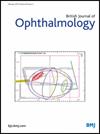Incidence and reasons for discontinuation of anti-VEGF treatment in neovascular age-related macular degeneration
IF 3.7
2区 医学
Q1 OPHTHALMOLOGY
引用次数: 0
Abstract
Purpose To explore the factors and frequency of interruptions in intravitreal treatment for patients with neovascular age-related macular degeneration (AMD) and to evaluate the demographic and clinical factors linked to the reasons for discontinuation. Methods In this multicentre study, patients who began anti-vascular endothelial growth factor (VEGF) treatment between January 2019 and December 2021 for treatment-naïve neovascular exudative AMD were retrospectively analysed. The overall incidence of treatment discontinuation, along with the rates for each specific cause, was calculated. The probability of each cause of discontinuation over time from the start of treatment, as well as the risk factors associated with each case, was also determined. Results 655 individuals (28.5%) discontinued intravitreal anti-VEGF therapy. Among the five main categories of causes for discontinuation (patient’s decision against clinician’s advice, continuation of therapy at another clinic, clinical decision, systemic diseases or death), clinical decision emerged as the most common reason for interruption. The qualitative evaluation of the Kaplan–Meier curves suggests a higher frequency of the clinical decision as a cause of discontinuation within the initial 2 years of treatment. Worse visual acuity increased the risk of discontinuation due to clinical decisions. Younger patients were more likely to stop anti-VEGF therapy by choice. Better visual acuity and longer distance from the clinic increased the likelihood of patients continuing treatment elsewhere. Conclusions The discontinuation of anti-VEGF treatment is common among individuals with neovascular AMD. Causes of discontinuation include not only clinician decisions but also those related to the patient’s health and personal choices. Data are available upon reasonable request. Data are available upon reasonable request to the corresponding author.新生血管性年龄相关性黄斑变性患者抗vegf治疗的发生率及停药原因
目的 探讨新生血管性年龄相关性黄斑变性(AMD)患者中断玻璃体内治疗的因素和频率,并评估与中断原因相关的人口统计学和临床因素。方法 在这项多中心研究中,对2019年1月至2021年12月期间开始接受抗血管内皮生长因子(VEGF)治疗的治疗无效新生血管性渗出性AMD患者进行了回顾性分析。计算了治疗中断的总体发生率以及每个特定原因的发生率。此外,还确定了从开始治疗起的一段时间内,每种原因导致中断治疗的概率,以及与每种情况相关的风险因素。结果 655 人(28.5%)中断了玻璃体内抗 VEGF 治疗。在中断治疗的五大类原因(患者不听从临床医生建议、在其他诊所继续治疗、临床决定、系统性疾病或死亡)中,临床决定是最常见的中断原因。对 Kaplan-Meier 曲线进行的定性评估表明,在治疗的最初两年内,临床决定作为中断原因的频率较高。视力下降增加了因临床决定而中断治疗的风险。年轻患者更有可能选择停止抗血管内皮生长因子治疗。视力较好和距离诊所较远的患者更有可能在其他地方继续治疗。结论 中止抗血管内皮生长因子治疗在新生血管性黄斑变性患者中很常见。中断治疗的原因不仅包括临床医生的决定,还包括与患者健康和个人选择有关的原因。如有合理要求,可提供相关数据。如有合理要求,可向通讯作者索取数据。
本文章由计算机程序翻译,如有差异,请以英文原文为准。
求助全文
约1分钟内获得全文
求助全文
来源期刊
CiteScore
10.30
自引率
2.40%
发文量
213
审稿时长
3-6 weeks
期刊介绍:
The British Journal of Ophthalmology (BJO) is an international peer-reviewed journal for ophthalmologists and visual science specialists. BJO publishes clinical investigations, clinical observations, and clinically relevant laboratory investigations related to ophthalmology. It also provides major reviews and also publishes manuscripts covering regional issues in a global context.

 求助内容:
求助内容: 应助结果提醒方式:
应助结果提醒方式:


